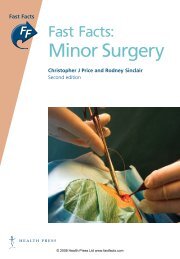You also want an ePaper? Increase the reach of your titles
YUMPU automatically turns print PDFs into web optimized ePapers that Google loves.
© 2004 Health Press Ltd. www.fastfacts.com
Acne<br />
Alison M Layton MB ChB MRCP<br />
Consultant Dermatologist<br />
Harrogate District Hospital<br />
Harrogate, UK<br />
Diane Thiboutot MD<br />
Associate Professor of Dermatology<br />
Pennsylvania State University College of Medicine<br />
Hershey, Pennsylvania, USA<br />
Vincenzo Bettoli MD<br />
Assistant Professor<br />
Department of Dermatology<br />
University of Ferrara, Italy<br />
Oxford<br />
HEALTH PRESS<br />
© 2004 Health Press Ltd. www.fastfacts.com
<strong>Fast</strong> <strong>Facts</strong> – Acne<br />
First published January 2004<br />
Text © 2004 Alison M Layton, Diane Thiboutot, Vincenzo Bettoli<br />
© 2004 in this edition Health Press Limited<br />
Health Press Limited, Elizabeth House, Queen Street, Abingdon,<br />
Oxford OX14 3JR, UK<br />
Tel: +44 (0)1235 523233<br />
Fax: +44 (0)1235 523238<br />
<strong>Fast</strong> <strong>Facts</strong> is a trademark of Health Press Limited.<br />
All rights reserved. No part of this publication may be reproduced,<br />
stored in a retrieval system, or transmitted in any form or by any means,<br />
electronic, mechanical, photocopying, recording or otherwise, without<br />
the express permission of the publisher.<br />
The rights of Alison M Layton, Diane Thiboutot and Vincenzo Bettoli to<br />
be identified as the authors of this work have been asserted in accordance<br />
with the Copyright, Designs & Patents Act 1988 Sections 77 and 78.<br />
Alison Layton is grateful to Professor William Cunliffe for advice and the<br />
provision of some illustrations.<br />
The publisher and the authors have made every effort to ensure the<br />
accuracy of this book, but cannot accept responsibility for any errors or<br />
omissions.<br />
Registered names, trademarks, etc. used in this book, even when not<br />
marked as such, are not to be considered unprotected by law.<br />
A CIP catalogue record for this title is available from the British Library.<br />
ISBN 1-899541-73-X<br />
Layton, AM (Alison)<br />
<strong>Fast</strong> <strong>Facts</strong> – Acne/<br />
Alison M Layton, Diane Thiboutot, Vincenzo Bettoli<br />
Medical illustrations by Dee McLean, London, UK.<br />
Typesetting and page layout by Zed, Oxford, UK.<br />
Printed by Fine Print (Services) Ltd, Oxford, UK.<br />
Printed with vegetable inks on fully biodegradable and<br />
recyclable paper manufactured from sustainable forests.<br />
© 2004 Health Press Ltd. www.fastfacts.com<br />
Low<br />
chlorine<br />
Sustainable<br />
forests
Clinical features of the various forms of acne 19<br />
Physical treatments for acne and scarring 64<br />
© 2004 Health Press Ltd. www.fastfacts.com<br />
Introduction 5<br />
Epidemiology 7<br />
Etiology and pathophysiology 10<br />
Psychosocial aspects 16<br />
Topical therapy 37<br />
Oral therapy 46<br />
Designing an acne treatment plan 67<br />
Future trends / areas of need 74<br />
The Leeds Acne Grading System 76<br />
Useful addresses 81<br />
Index 83
Introduction<br />
Acne (Figure 1) is one of the commonest skin diseases that community<br />
physicians and dermatologists have to treat. Confirming the diagnosis<br />
is rarely a problem and, given the wide spectrum of treatment options,<br />
there really is no reason why most patients with acne cannot be helped<br />
enormously. However, the vast number of therapeutic options now<br />
available can pose difficulties for the prescribing clinician in deciding<br />
which is the preferred treatment. The purpose of this guide is to<br />
highlight several features of the disease, including etiology and clinical<br />
presentation, while also reviewing the treatments available along with<br />
their respective modes of action and potential adverse effects.<br />
Successful management of acne requires careful selection of antiacne<br />
agents according to clinical presentation and individual patient needs. A<br />
thorough patient evaluation should take into account acne severity and<br />
© 2004 Health Press Ltd. www.fastfacts.com<br />
Figure 1 A typical<br />
example of common<br />
acne.<br />
5
<strong>Fast</strong> <strong>Facts</strong> – Acne<br />
6<br />
predominant lesion type as well as age, skin type, lifestyle, motivation<br />
and the presence of coexisting conditions. Incorporation of all these<br />
factors, along with appropriate education when choosing a specific<br />
treatment program, can enhance patient compliance and satisfaction,<br />
which is essential for the success of acne treatment. The recent<br />
introduction of several new antiacne agents affords greater flexibility in<br />
treatment. The availability of new treatment options to complement the<br />
existing armamentarium should help to achieve the successful therapy<br />
of greater numbers of acne patients, ensure improved tolerability and<br />
fulfill patient expectations.<br />
© 2004 Health Press Ltd. www.fastfacts.com
1 Epidemiology<br />
Acne can affect persons of all ages, including neonates, infants,<br />
prepubescent children, adolescents and mature adults. However,<br />
acne is most prevalent and most severe during adolescence.<br />
Neonatal acne (Figure 1.1) is characterized by the development<br />
of comedones, and inflammatory papules and pustules which<br />
generally affect the cheeks. It is thought to result from the production<br />
of androgens by the fetal adrenal glands and testes. Neonatal acne<br />
usually resolves within the first 3 months of life, but can persist for<br />
up to a year.<br />
In females, acne becomes active again at the time of adrenarche,<br />
generally around 8 to 10 years of age. The onset of acne in this period<br />
has been associated with elevated levels of dehydroepiandrosterone<br />
sulfate (DHEAS), a weak adrenal androgen. Most prepubertal acne is<br />
characterized by the presence of comedones and few inflammatory<br />
lesions.<br />
Acne vulgaris typically begins around puberty and early adolescence;<br />
thus it tends to present earlier in females than males, reaching peak<br />
severity in females at about the age of 17, and at 19 or 20 years in<br />
Figure 1.1 Neonatal acne.<br />
© 2004 Health Press Ltd. www.fastfacts.com<br />
7
4 Clinical features of the various<br />
forms of acne<br />
Lesion types<br />
Acne vulgaris is the most common type of acne. Other types are<br />
described later in this chapter. The individual lesions of acne vulgaris<br />
are divisible into three types:<br />
• non-inflamed lesions<br />
• inflamed lesions<br />
• scars.<br />
Non-inflamed lesions are called comedones. Comedones may be<br />
microscopic (microcomedones) (Figure 4.1) or evident to the eye as<br />
blackheads or whiteheads (Figure 4.2). Microcomedones, the precursor<br />
lesions of acne, may develop into whiteheads or blackheads.<br />
• Whiteheads (closed comedones) are small spots (about 1 mm in size)<br />
and are usually white or cream in color. Macrocomedones are large<br />
closed comedones, usually > 2 mm in diameter, and are usually white<br />
in color and palpable (Figure 4.3).<br />
Sebaceous<br />
gland<br />
Hair<br />
Follicular duct<br />
Microcomedone<br />
Figure 4.1 A microcomedone, the precursor lesion of acne.<br />
© 2004 Health Press Ltd. www.fastfacts.com<br />
Skin surface<br />
Epidermis<br />
Dermis<br />
19
<strong>Fast</strong> <strong>Facts</strong> – Acne<br />
20<br />
Figure 4.2 Mixed non-inflammatory lesions: blackheads and whiteheads.<br />
Figure 4.3<br />
© 2004 Health Press Ltd. www.fastfacts.com<br />
Macrocomedones: closed<br />
comedones of diameter<br />
> 2 mm.















